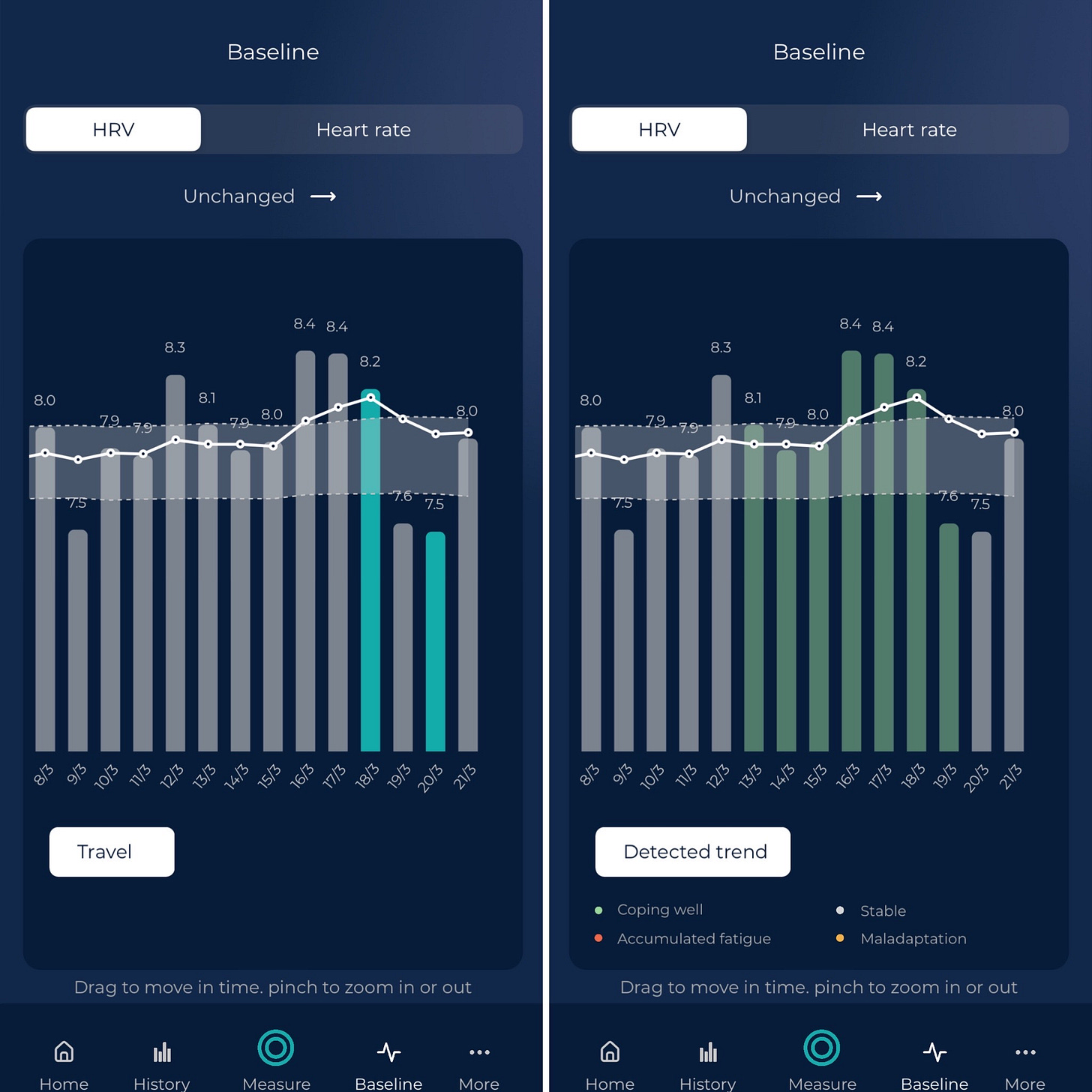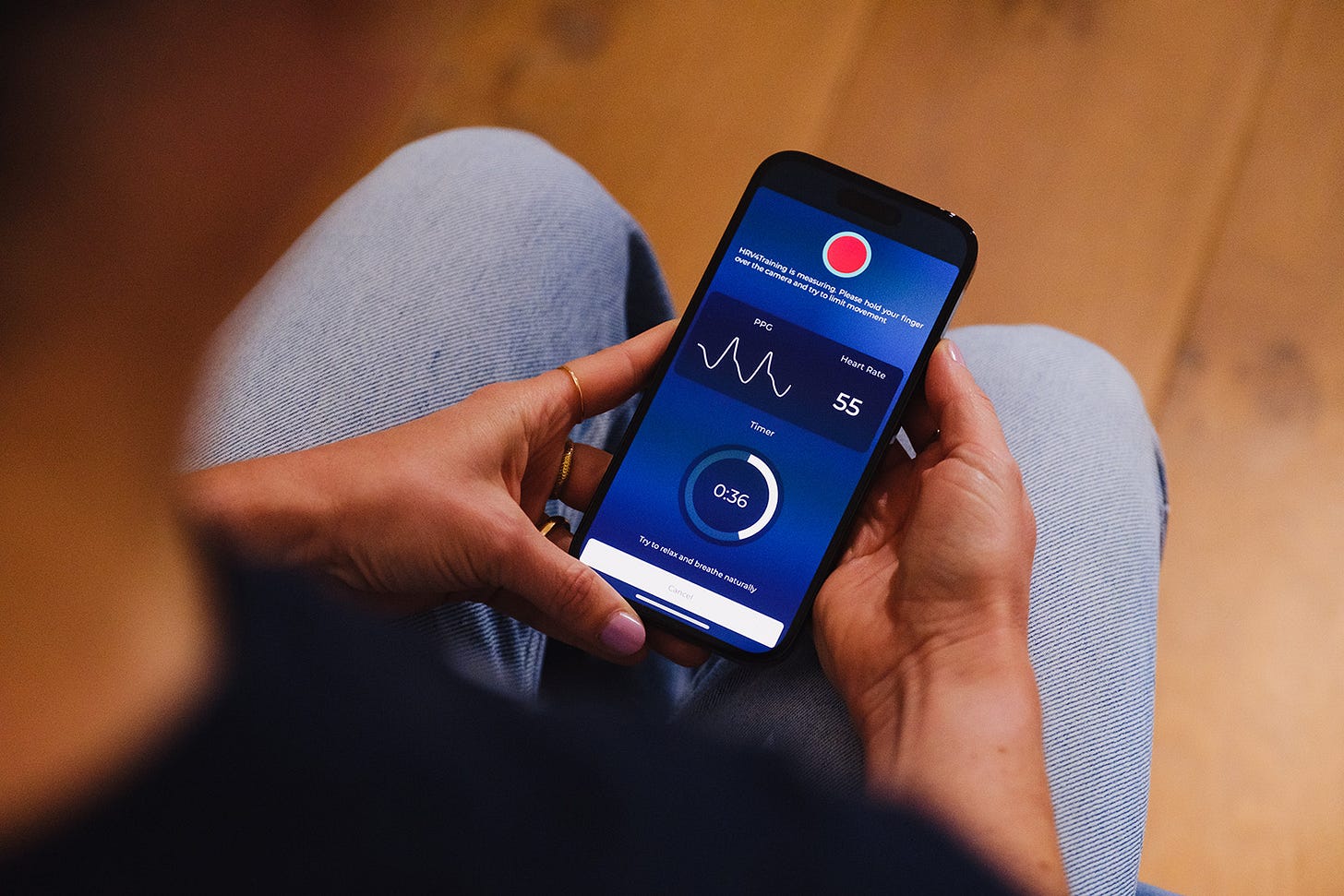Week 09: Cold Exposure and HRV
And a few more notes on caloric deficit, macronutrient distribution, and resting physiology
Hi there,
I hope everything is well.
Today I’d like to cover an interesting topic, cold exposure, and discuss possible misconceptions when using HRV to assess our acute response to this (or other!) stressors.
In particular, cold exposure acutely increases HRV. However, the bigger question is, does the change in HRV reflect an actual change in recovery?
To answer this question, I think about the physiology. Here is what happens with this stressor: cold exposure leads to vasoconstriction, which leads to increased blood pressure, which leads to reduced heart rate via the baroreflex (the mechanism that tightly regulates heart rate and blood pressure). Based on these mechanisms, the change in HRV might just be due to a reduction in heart rate due to the baroreflex, and as such, it might not reflect improved recovery - it is a sort of physiological artifact.
We need to keep in mind that vasoconstriction is under sympathetic control, while the reason why we use HRV is that it normally captures changes in parasympathetic activity, our marker of recovery (hence, normally, we have an increase of parasympathetic activity and reduction in sympathetic activity, which we could associate to better recovery). With cold exposure, the change in HRV is the result of a co-activation of the sympathetic and parasympathetic systems, initially triggered by the sympathetic system. As such, these changes might have nothing to do with our typical oversimplification of “higher HRV as better recovery”. Yes, physiology is a mess, and we oversimplify a lot (often, too much!).
This is the issue of using HRV as a proxy of parasympathetic activity or “stress” without understanding the underlying physiology and how HRV (i.e. practically speaking, the variability between heartbeats) can change for a number of reasons, some of them unrelated to parasympathetic activity (which is also why good measurement protocols are so important!), others linked to parasympathetic activity only indirectly (e.g. in case of a baroreflex change triggered by higher sympathetic activity, as in vasoconstriction due to cold exposure). Needless to say, without this level of context, it makes no sense to interpret continuously collected HRV data as a marker of parasympathetic activity or “stress” (have I said that enough times?).
Where do we go from here?
Given that the change in HRV is driven by a suppression in resting heart rate, I would think that in this context as well (as previously discussed also for caloric deficit), normalized HRV could be a better marker of our stress response or recovery than HRV alone, as Normalized HRV would not conflate the change in HRV due to a suppression in heart rate.
Keep in mind that here we only cover the autonomic nervous system side of things, and cold exposure might have other recovery-related benefits (e.g. at the muscular level), that are typically not captured by HRV and therefore not part of these considerations.
To conclude:
Use good protocols, and beware of decontextualized or continuous data (i.e. measure your physiology intentionally, using best practices).
Understand the physiological mechanisms and avoid over-interpreting changes in markers that might decouple from the outcomes of interest (i.e. HRV is not always representative of parasympathetic activity, and might increase because of a response to an increase in sympathetic activity, as in the case of cold exposure). These issues are typical of acute stressors and measurements taken outside of what are typical recommendations to assess resting physiology. Morning measurements would not be impacted in a meaningless way, as they are far enough from the stressors.
Look at HRV normalized by heart rate, as an additional marker that might be less susceptible to certain issues, such as the ones described above (or similar ones happening e.g. when in a caloric deficit). You can check your own Normalized HRV in the latest version of HRV4Training Pro (select HRV:HR as the physiological parameter to plot).
You can learn more about Normalized HRV, in this blog.

Data update: caloric deficit and shifting to a lower-carb diet
I discussed a few weeks ago changes in resting physiology during a caloric deficit and when changing macronutrient distribution (e.g. shifting to a lower-carb diet), see here.
In particular, after an initial increase in HRV, typically due to a large reduction in resting heart rate, I had seen a suppression in HRV with no change in heart rate, when shifting to a lower-carb diet. A similar, short-lived pattern, was reported in a study by Dostal et al.
Consistently with published research, my HRV data has also re-normalized after an initial phase in which there was a large suppression, possibly due to a combination of a reduction in blood volume (another physiological artifact that should not be overinterpreted as “positive or negative”, regardless of HRV), and an actual stress response.
In terms of resting heart rate, it seems to be a good meter for caloric deficit, and nothing else. We can see how in resting heart rate the shift to a different macronutrient distribution does not impact the data, and how resting heart rate re-normalizes as soon as the caloric deficit stops.

Discount for HRV4Training Pro: 20% off 🖥️
HRV4Training Pro is the ultimate platform to help you analyze and interpret your physiological data, for individuals and teams.
You can find a guide and overview here.
Try HRV4Training Pro for free at HRVTraining.web.app or use promo code SCIENCE for 20% off.
While we really appreciate the pledges on Substack, our writing here will always remain free, and Pro is the best way to support our work.
I thank you for that.
When using Pro, the app will also automatically recognize your account and add the Normal Range to the Baseline view, together with detected trends and additional annotations, which can help contextualizing longer-term changes.
You will also be able to pick rMSSD as the parameter to see on the homepage of the app.

See you next week!
Marco holds a PhD cum laude in applied machine learning, a M.Sc. cum laude in computer science engineering, and a M.Sc. cum laude in human movement sciences and high-performance coaching.
He has published more than 50 papers and patents at the intersection between physiology, health, technology, and human performance.
He is co-founder of HRV4Training, advisor at Oura, guest lecturer at VU Amsterdam, and editor for IEEE Pervasive Computing Magazine. He loves running.
Social:







Great insight. We always have to consider what is a true effect and what is physiological or artifact. I’m happy to have clicked on the email today and have followed your Substack, opened the app for the first time in a while, and doing a 30d trial of pro. $49 is not too much to ask for a year but I need to be sure I’m actually using the information. I miss you on Twitter. I’m @PrimaryCarePAC. Where are you most active?